If you haven't purchased a new tablet in recent years, now is an excellent time to consider it. Tablets today are not only more powerful, but they also boast superior displays. Mainstream models now offer features once exclusive to more expensive flagship devices.
However, you might ask, what exactly defines a tablet? The presence of a touchscreen and the capability to operate without a physical keyboard attached provide a reasonable definition. By this standard, all modern smartphones could be considered tablets, but given their sizes and aspect ratios, which are optimized for phone usage, they are not the best companion devices for uses where a true tablet shines. So, what then are the best tablets?
Whether you need a tablet for work, study, content consumption, or web browsing, our buying guide has you covered. We'll introduce you to the best tablets across various categories. Apple's iPads remain the best devices in this form factor for most users, so we'll tell you which models offers the best value, as well as offer alternatives that are more budget-friendly, or are based on Android and Windows.
- Best for Most
- Best of the Best
- Best for Productivity
- Best Android Tablet
- Best for One-Hand Use
- Budget Options
The Best Tablet for Most People
Apple iPad 10.2" (9th-gen) and Apple iPad Air

Great | Differentiating Features
Unbeatable combination of price, performance, and features.
Good | Most Have It
Storage starts at 64GB.
Average | Competitors May Be Better
Bezels remain chunky. Lacks the display features and USB-C connector of most iPad models.
The Apple iPad line comfortably retains the tablet crown, despite the vast improvements made by Android and Windows tablets over the past few years. While several options are available at various price points, the 9th-gen iPad is now selling for $249, making it our pick as the best for most people.
The iPad's 10.2-inch Retina display offers 500 nits of brightness and the same 264 PPI (2160 x 1620) as the iPad Pros. It does lack several features of the more expensive models, but the iPad is colorful, crisp, and great for content consumption of all types. The stereo speakers at the bottom offer good audio output and there's also a 3.5mm headphone jack.
Apple launched a new 10th-gen iPad in 2022, but for at least $150 more, we can't call it a direct replacement. The main reason to consider the slightly larger 10.9" model is if you want a tablet that doubles as a low-end laptop: it has the same 12MP front camera but on the long edge, like a laptop rather than a phone, and supports the new Magic Keyboard Folio ($170), which offers function keys as well as a trackpad.
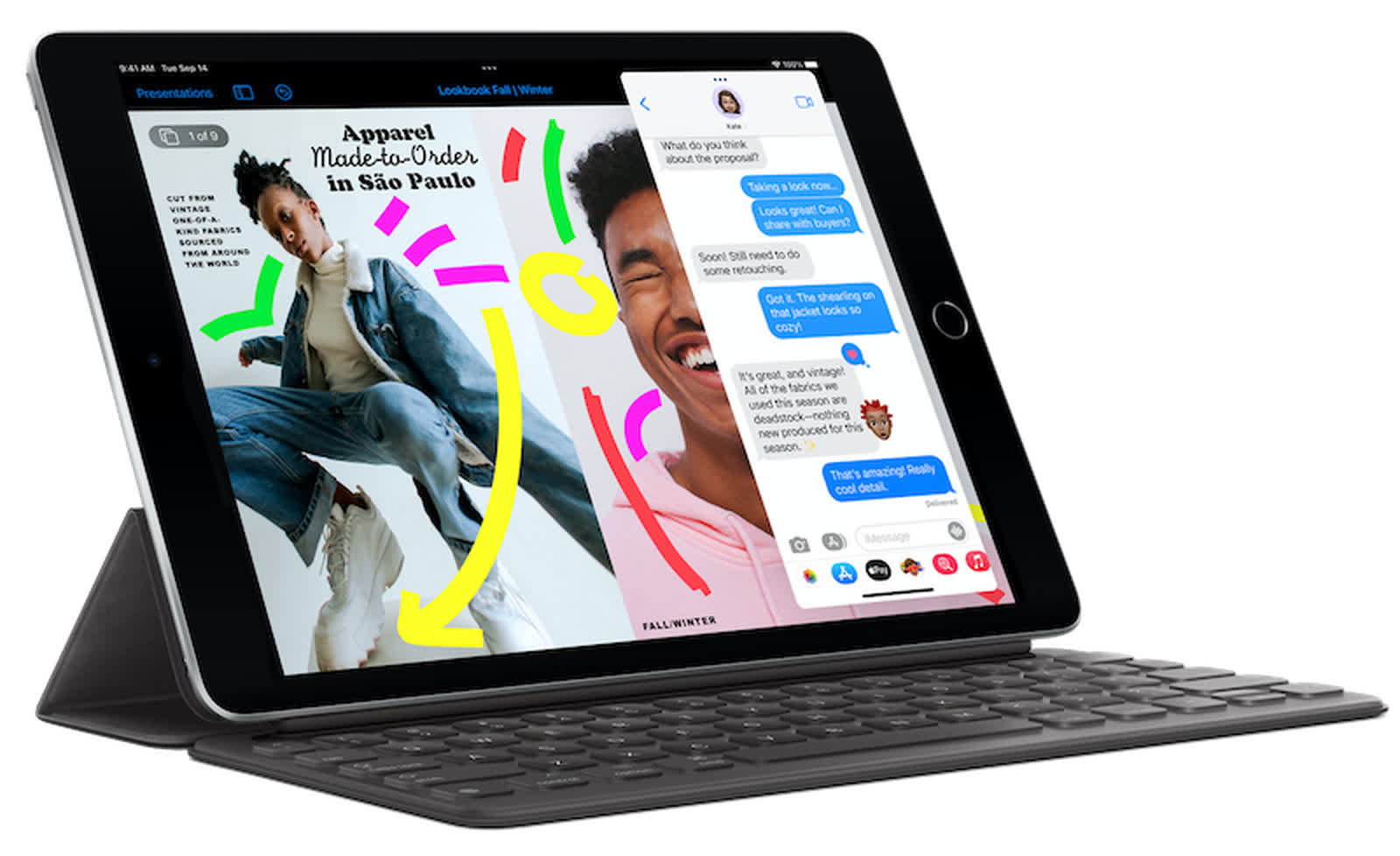
The option of the $80 USB-C Apple Pencil also makes the latest version a more appealing tablet for some users – the new Pencil doesn't feature pressure sensitivity, but at least it doesn't require an adapter like the older, Lightning-based Pencil.
Back to our 9th-gen iPad recommendation, it's powered by the A13 Bionic SoC, offering decent CPU and GPU performance. It's not the state-of-the-art M1 found in the iPad Air, but it's close enough to the A14 in the 2022 model to justify the savings. The 9th-gen iPad offers an 8MP rear camera and the same 10-hour battery and ultra wide 12MP front cam as the more expensive models. There's support for the first-gen Pencil ($80) and Smart Keyboard ($80). It comes with Touch ID and the old Lightning port instead of USB-C, and a 20W charger is included.
You also get iPadOS – the most complete tablet OS available. A brilliant combination of price, performance, and features make this an easy top choice for media consumption.
iPad Air: A worthy upgrade
If you don't need all of the iPad Pros' features and storage options but still want one of the best tablets for 60 FPS gaming or 3D modeling, the Air is an interesting middle ground. Discounted to ~$500 for the 64GB version, it's not as affordable as the base iPad and offers many of the Pro models' best features at a more reasonable price.
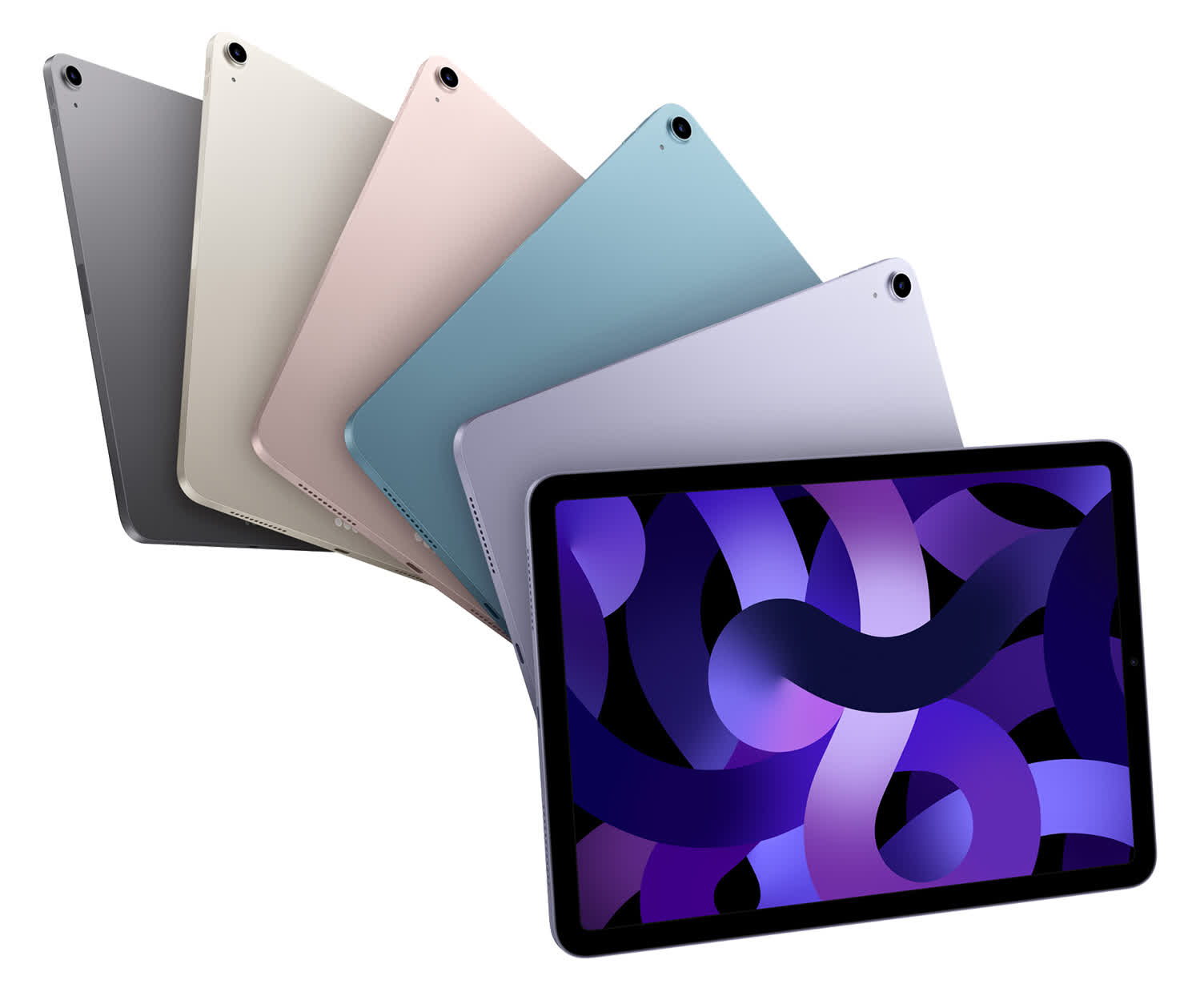
Some of the Air's advantages over the 10th-gen iPad include a fully laminated display with a wide color gamut and an anti-reflective coating; and support for the 2nd-gen Pencil ($90) which attaches magnetically to the side.
The Air also sports the more powerful M1 processor and 8GB of RAM, all wrapped in a thin and light design.
If you're happy to pay a bit more, the iPad Air is a top choice. At around $650, the 256GB version is still cheaper than the 128GB version of the 11" iPad Pro (see below).
Best of the Best
Apple iPad Pro 11"

Great | Differentiating Features
More power than you'll need on the M2 chip. 120Hz refresh rate display. Face ID. Solid camera array. 12.9" model gets mini-LED HDR capable display.
Good | Most Have It
Impressive battery life.
Average | Competitors May Be Better
Expensive. Still not a direct laptop replacement. Pencil and Magnetic Keyboard sold separately.
The iPad Pro 11" is the best tablet available on the market. It sports the same ProMotion display as previous models, boasting of a buttery-smooth 120Hz refresh rate, which makes scrolling a joy. The M2 chip outperforms the M1 in the iPad Air, particularly in graphics processing. Unlike the iPad Air, the USB-C connector supports USB4/Thunderbolt speeds, and the Wi-Fi + Cellular versions also support mmWave 5G.
For various professionals, the 11" Pro stands out as the top choice. Graphic artists will find drawing on the 120Hz display uniquely satisfying. Interior designers looking to showcase potential designs for kitchens or offices will find the LiDAR feature indispensable. Moreover, the bezels in the iPad Pro are slimmer than the Air's, and it's compatible with the same accessories.
You also get a 12MP front camera and four speakers.

There's also a larger 12.9-inch Pro available though it's overkill for most users unless you plan to take advantage of the higher quality and more expansive display. If you are a video editor who works on the go, the 12.9'' Pro might be the device of your dreams. The Mini-LED display with its 1600 nits of peak brightness (1000 for the whole screen), competes only with the very best and most expensive laptops.
The magnetic Magic Keyboard ($200 or $250 extra, depending on size) features a floating design and cantilevered hinges to support viewing angles of up to 130 degrees, plus the software integration to make this closer to becoming a laptop replacement – a decent attempt for casual users. The Apple Pencil (2nd-gen) is very responsive and delivers a very polished user experience, especially with the Pencil Hover feature.
The 11" iPad Pro starts at $799 for the Wi-Fi only version with 128GB and goes up from there as you add storage and RAM. Same goes for the 12.9" model that starts around $1,050 for the least expensive, Wi-Fi only, 128GB version. You don't even want to know how much a maxed out iPad costs, but for lovers of slates, there's none better.
Best Productivity Tablet
Microsoft Surface Pro 9
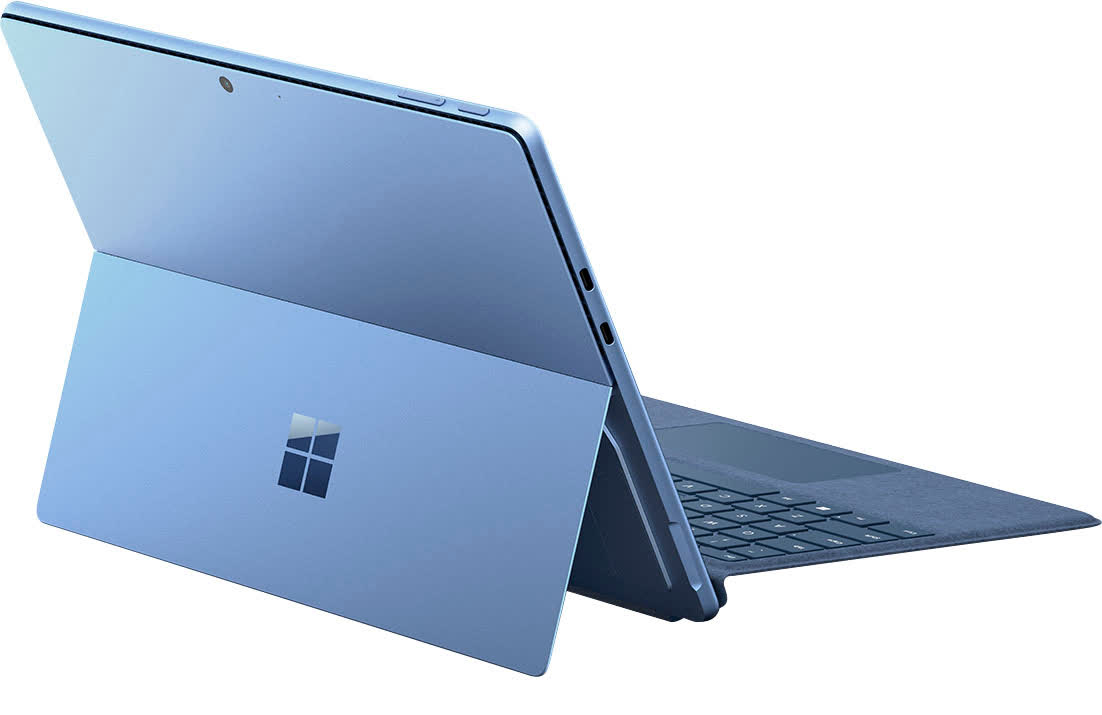
Great | Differentiating Features
Full Windows productivity on an Intel CPU. Two Thunderbolt 4 ports. Replaceable SSD. Stylus has haptic feedback.
Good | Most Have It
Gorgeous, 120Hz display and long battery life.
Average | Competitors May Be Better
Stylus and keyboard cost extra. Intel CPUs require active cooling.
The Microsoft Surface Pro 9 is a top choice for Windows productivity on the go. The 12th-gen Core processor packs two performance cores and eight efficiency cores for a total of 12 threads and efficient multi-core performance. You also get up to 32GB of LPDDR5 memory, two Thunderbolt 4 ports (but no USB Type-A), and a solid case with a kickstand that allows it to be used at different angles.
The 120Hz IPS display (2880 x 1920) uses the 3:2 aspect ratio we've come to expect from Surface devices, making it great for productivity work. You also get a 10-megapixel camera on the rear and a 1080p cam on the front for Windows Hello.
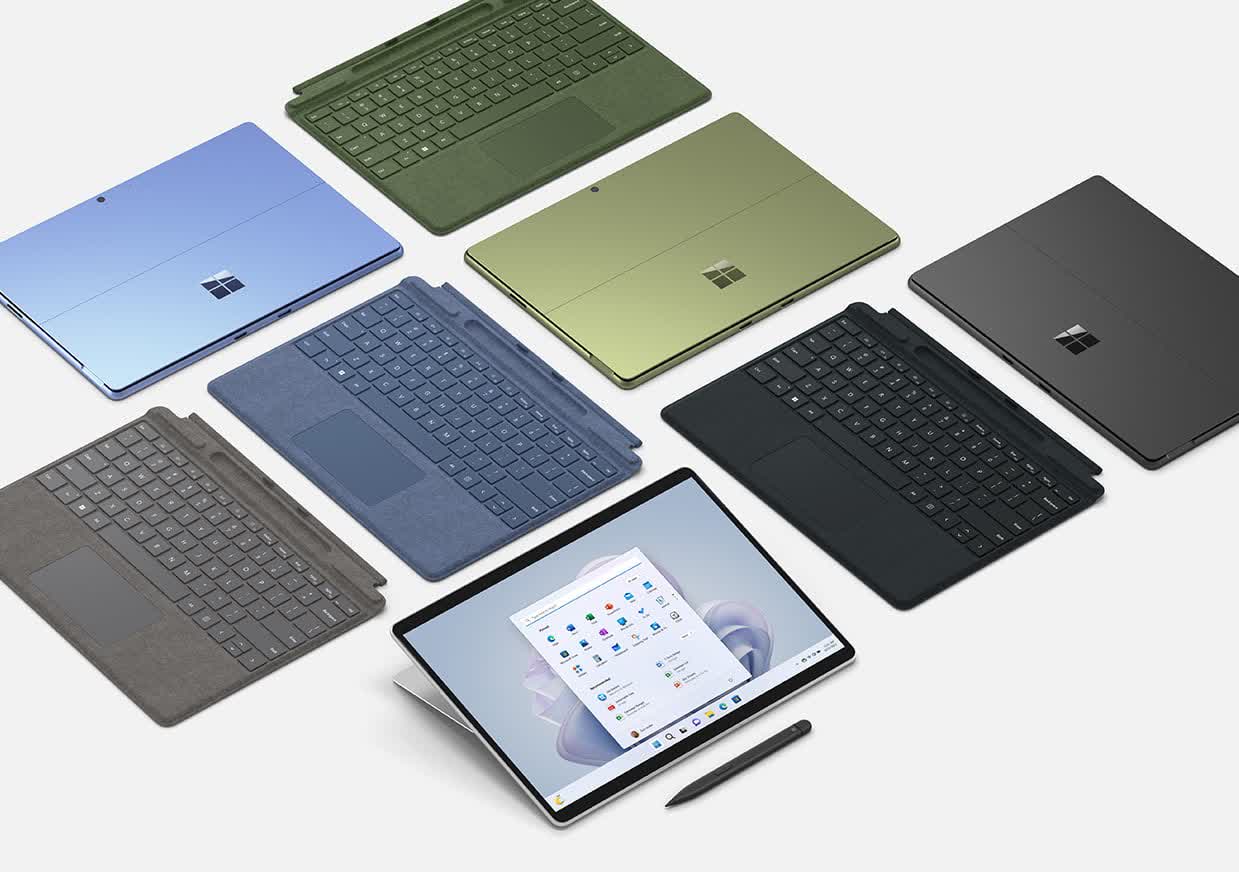
While the top-specced machine with a Core i7 CPU and a 1TB SSD can cost as much as $2,600, a model with an almost identical Core-i5 CPU, 8GB of RAM and a replaceable 256GB SSD (see upgrade recommendations) can be had for $800.
The Slim Pen 2 charges wirelessly and provides haptic feedback, and the Signature Keyboard uses backlit, mechanical keys. The downside is that, like with iPads, the keyboard and stylus cost extra.
The 5G version of the Surface Pro is a direct competitor to the iPad Pro, with the passively-cooled SQ3 Arm processor, USB-C 3.2, up to 16GB of LPDDR4x RAM and 512GB of storage, and optional cellular connectivity. Starting at $1,100 with 8GB of RAM and 128GB of storage, it's a tougher sell when the previous-gen Surface Pro X with SQ2, USB-C 3.0, 16GB of RAM, a 256GB SSD and 4G cellular connectivity can be had for $800.
Best ChromeOS Tablet
Lenovo IdeaPad Duet 5
If you want something cheaper than a Surface but more suitable than an Android tablet for productivity, then Lenovo's IdeaPad Duet 5 Chromebook is an interesting option.

For $470 you can get it with modest internals, including the Snapdragon SC7180, 4GB of RAM and 64GB of storage; a stylus and a detachable keyboard. The 13.3" OLED display supports a wide color gamut, and you also get four speakers, two microphones, a 5MP front cam and an 8MP rear one.
Best Android Tablet
Samsung Galaxy Tab S8+

Great | Differentiating Features
Super AMOLED 120Hz display. Snapdragon 8 Gen 1 SoC. Included S-Pen. Android updates until 2027.
Good | Most Have It
Sleek design. Good battery life, cameras, and speakers.
Average | Competitors May Be Better
Android on tablets is still in the shadow of iPadOS. Performance can't match Apple's flagship.
Much like in the phone business, Apple's main rival in the tablet market is Samsung – well, except for Microsoft. Despite the release of the Galaxy Tab S9, the 12.4" Tab S8+ remains our top tablet recommendation for Android fans. It's currently discounted at $599 for the base Wi-Fi version with 8GB of RAM and 128GB of storage, making it bigger and cheaper than the 11" Tab S9.
Both S8+ and S9 tablets use a 120Hz Super AMOLED panel, with vibrant colors and perfect blacks. Both feature face recognition and have in-screen fingerprint readers as well as four speakers, USB 3.0 Type-C, and an ultrawide 12MP front camera.
An advantage over the iPad Pro is that Samsung's stylus is free in the box, rather than requiring another outlay.

The Galaxy Tab S9 is still a good option thanks to its IP68 water and dust resistance. The S9 series is powered by the Snapdragon 8 Gen 2, which is more powerful than the Gen 1 chip in the S8, but still not in the same performance ballpark as the iPad Pro's M2. It starts at $757, but at that point it's too tempting to add $72 for double the storage and 12GB of RAM. That option in turn is close in price to the $947 Tab S9+ with the same internals.
If you prefer screen size and multitasking capabilities over portability and value, the 14.6" Galaxy Tab S Ultra is the one for you. It also has an additional 12MP camera in the front. The S8 Ultra starts at $950 with 8GB of RAM and 128GB of storage. You can upgrade to 12GB of RAM and 256GB of storage for $100, but we have found an S9 Ultra with the same specs for $1,100.
Regardless of your size preference, you'll have to deal with somewhat disappointing software. Android on tablets has come a long way, and you do get DeX mode, so compatible apps work in windowed versions, but iPadOS remains superior.
One step down: Smaller, not slower
Samsung has launched the Galaxy Tab S9 FE, powered by its own Exynos 1380 chip, a 90Hz LCD screen with less pixels per inch, USB 2.0 Type-C and two speakers. We still believe the basic Tab S8 will be a better purchase, with the Snapdragon 8 Gen 1, a 120Hz LCD display, USB 3.0 Type C, four speakers and 8GB of RAM even on the cheapest version with 128GB of storage.
A true alternative: OnePlus Pad
Many companies make Android tablets, but for most their key feature is being cheaper than the Galaxy Tab.
The OnePlus Pad is different in a very obvious way: it's got a unique 7:5 aspect ratio, so it's just 40% wider than it is tall. That makes it much more comfortable to use in portrait mode.
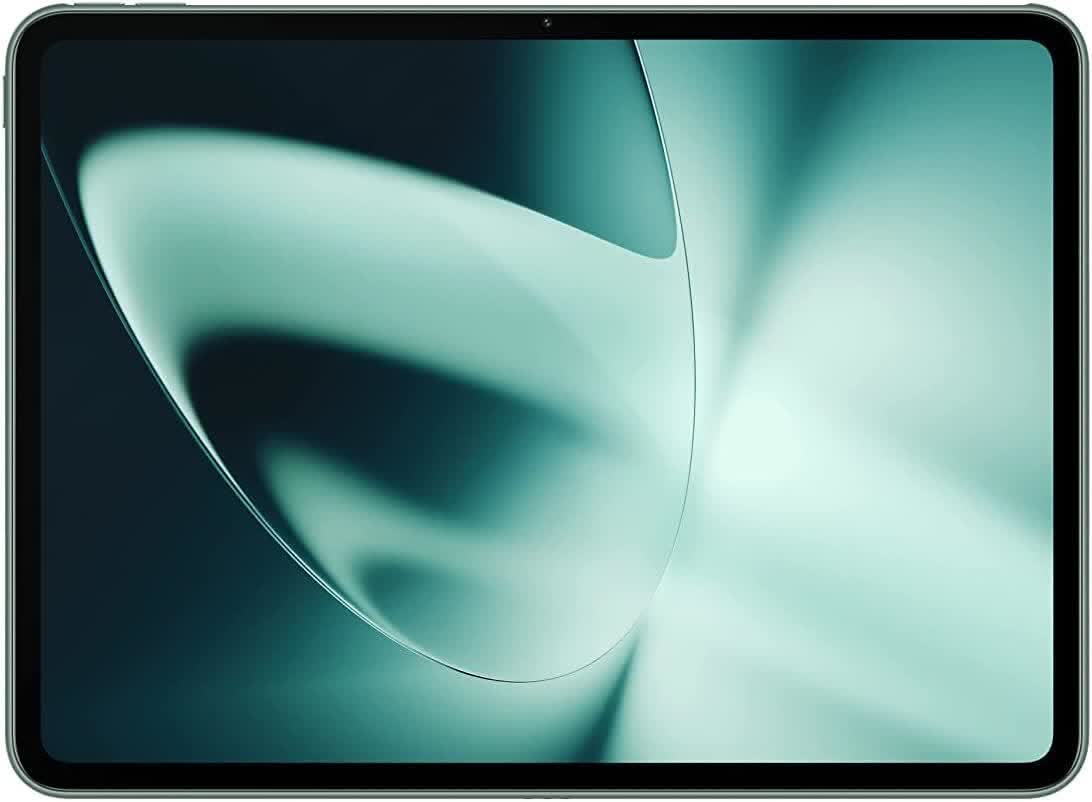
The 144Hz LCD display features true 8-bit color (10-bit with FRC) for accurate reproduction. At 11.61", it has the same number of pixels (2,800) as the S8+ in each line, and a rounded-up number of 2,000 lines. With four speakers, face recognition, 67W charging and an 8MP front camera, the OnePlus Pad isn't missing anything for content consumers.
Launched for $480, as of writing it can be had for $400 with 8GB of RAM and 128GB of storage. It has an optional magnetic stylus for $70, and a magnetic keyboard with a trackpad for $100, but it wouldn't be our first choice for content creation.
The MediaTek Dimensity 9000 chip isn't as fast as the Snapdragon 8. Also, OxygenOS is a much lighter Android modification than One UI, meaning than the OnePlus Pad will feel like an oversized phone more often than the Tab S.
The Best Tablet for One-Hand Use
Apple iPad Mini

Great | Differentiating Features
A15 SoC is faster than the iPad 10th-gen. Pixel density is 326ppi. Support for 2nd-gen Apple Pencil.
Good | Most Have It
Easy to hold with a single hand. 10-hour battery life. Sub-6GHz 5G speed support on the Wi-Fi + Cellular version.
Average | Competitors May Be Better
Keyboard support limited to Bluetooth.
Tablets smaller than 9 inches are usually budget devices with outdated hardware and older Android versions, but the iPad Mini is a glaring exception. Regardless of size, the Mini is better than the vast majority of tablets on the market.
With a 2266x1488 resolution, its 8.3" display actually has the highest pixel density of all iPads (326ppi), and also the highest aspect ratio (just over 3:2). It sports the A15 Bionic chip, which is faster than the 10th-gen iPad's A14, and 4GB of RAM.
That's not close to what the iPad Air offers, but if you can get the Mini for $400 (depending on the color), it's harder to complain about that. The Wi-Fi + Cellular version does support sub-6GHz 5G speeds, like the iPad Air. It also has the same ultra-wide 12MP front camera and 12MP wide rear camera.
The Mini doesn't support the Smart Keyboard or Magic Keyboard, but it supports the 2nd-gen Pencil. The base model comes with 64GB of storage and Wi-Fi, and for $150 more you get 256GB of internal storage.
Budget Options
Amazon Fire HD 10 (2023)

Great | Differentiating Features
Won't find anything better at this price. Good screen, speakers, and battery life
Good | Most Have It
USB-C
Average | Competitors May Be Better
Cameras are not the best. Very Amazon-focused. Limited apps
It's a case of buyer beware when purchasing a budget tablet. There are plenty of sub-$100 and even sub-$200 slates that simply aren't worth your time nor money. But Amazon's latest Fire HD 10, which runs the Android-based Fire OS, is a good option at around $80 for the 32GB storage model – though you will want to pay the extra $15 to remove the ugly ads on the lock-screen.
The 2023 iteration of the Fire HD 10 has received a thinner and lighter design, a 5MP front camera, and support for a $35 pressure-sensitive tilt-supporting stylus. Internally, it's the same as the previous model, with 3GB of RAM, 32GB and 64GB storage options (expandable up to 1TB via microSD), and a newer but similar 8-core processor, all of which are fine for that low price point.

With a crisp, bright screen and fairly loud speakers, the Fire HD 10 is a cost-effective device for those who use tablets sparingly for content consumption, or if you want something cheap for your kids, and it's even more useful if you have a Prime subscription. The Fire 10 features Alexa, allowing it to work in the same way as Amazon's many Echo devices. But you can only access Amazon's App store, so no Google services – unless you're willing to side-load them.
Budget Android option
Samsung Galaxy Tab A8
If you want a tablet with a fully fledged OS and solid software support, the Samsung Galaxy Tab A8 ($200 with 128GB of storage and 4GB of RAM, cheaper with less storage) comes with everything you need from a content consumption-focused tablet: the 1920x1200 (216 PPI), 10.5" screen is vibrant and colorful, the speakers and battery life are excellent, and the build is sturdy.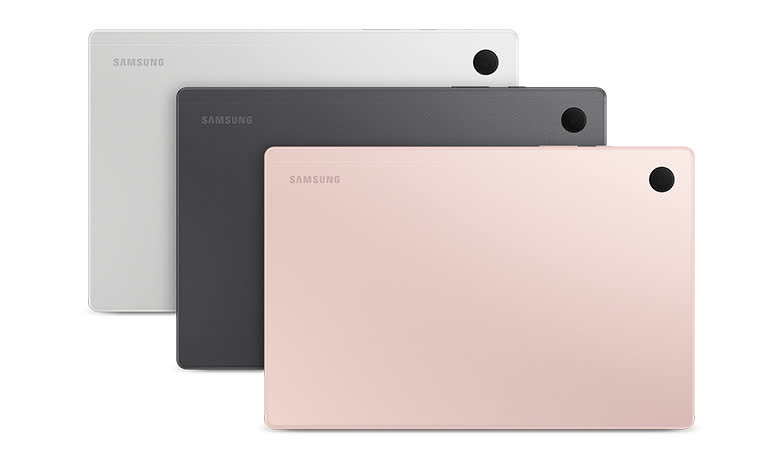
The similar (11" display, same resolution) but faster Galaxy Tab A9 Plus has only been released in smaller markets so far, but if you can get it for a similar price it's a no-brainer, especially if you want the LTE version, which was upgraded with 5G support.
Samsung's tablet also comes with features you'd expect to find on more expensive models, including facial recognition and USB-C charging. The Unisoc Tiger T618 SoC isn't on par with the entry-level iPad's A13, and the cameras aren't great, but the tablet is still cheaper than Apple's slate even with more storage.

